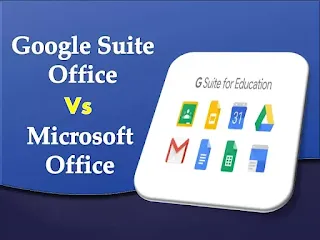Google Suite Office vs. Microsoft Office: Which is Right for You?
If you're in the market for office productivity software, you may be considering Google Suite Office and Microsoft Office. Both options offer a range of features and benefits, but which one is right for you? This comparison guide will break down the key differences between the two, helping you make an informed decision.Google Suite Office vs. Microsoft Office
Pricing and Plans
When it comes to pricing and plans, both Google Suite Office and Microsoft Office offer a variety of options to suit different budgets and needs. Google Suite Office offers a flexible pricing structure, with plans starting at $6 per user per month for the Basic plan, which includes 30GB of storage. They also offer a Business plan for $12 per user per month, which includes unlimited storage and additional features like advanced admin controls and data loss prevention.On the other hand, Microsoft Office offers a subscription-based pricing model with plans starting at $5 per user per month for the Office 365 Business Essentials plan, which includes online versions of Office apps and 1TB of OneDrive storage. They also offer the Office 365 Business plan for $8.25 per user per month, which includes desktop versions of Office apps and 1TB of OneDrive storage.Ultimately, the choice between Google Suite Office and Microsoft Office will depend on your specific needs and budget. It's important to carefully consider the features and benefits of each option before making a decision.
Collaboration and Sharing
Both Google Suite Office and Microsoft Office offer collaboration and sharing features that allow multiple users to work on documents, spreadsheets, and presentations simultaneously.Google Suite Office uses Google Drive as its cloud storage platform, allowing users to easily share files and collaborate in real-time. Users can grant different levels of access to collaborators, such as view-only or editing permissions. Google Suite Office also includes features like comments and suggestions, making it easy for team members to provide feedback and make changes to documents.Microsoft Office, on the other hand, uses OneDrive as its cloud storage platform. Like Google Drive, users can easily share files and collaborate in real-time. Microsoft Office also offers features like co-authoring, where multiple users can work on a document at the same time.
Additionally, Microsoft Office includes features like track changes and version history, allowing users to see and revert to previous versions of a document.
Both Google Suite Office and Microsoft Office offer robust collaboration and sharing features, but the specific tools and interface may vary. It's important to consider your team's preferences and workflows when deciding which option is right for you.
Document Creation and Editing
Both Google Suite Office and Microsoft Office offer powerful document creation and editing tools. Google Suite Office includes Google Docs, which allows users to create and edit documents online. It offers a wide range of formatting options, including fonts, colors, and styles. Users can also insert images, tables, and links into their documents. Google Docs also supports real-time collaboration, allowing multiple users to work on a document simultaneously.Microsoft Office includes Microsoft Word, which is a widely-used word processing program. It offers a comprehensive set of tools for creating and editing documents, including formatting options, templates, and styles. Users can also insert images, tables, and links into their documents. Microsoft Word also supports real-time collaboration, allowing multiple users to work on a document at the same time.Both Google Docs and Microsoft Word have their own unique features and interface, so it's important to consider your team's preferences and needs when deciding which option is right for you.
Storage and File Management
When it comes to storage and file management, Google Suite Office and Microsoft Office offer different options. Google Suite Office provides users with 15 GB of free storage through Google Drive. This storage can be used to store documents, photos, videos, and other files. Users can also purchase additional storage if needed. Google Drive allows users to easily organize their files into folders and share them with others. It also offers the ability to access files from any device with an internet connection.On the other hand, Microsoft Office offers OneDrive for storage and file management. With a Microsoft account, users get 5 GB of free storage, with the option to purchase more if needed. OneDrive allows users to store and organize their files, and it also integrates seamlessly with other Microsoft Office applications. Users can access their files from any device and easily share them with others.Ultimately, the choice between Google Suite Office and Microsoft Office for storage and file management depends on your specific needs and preferences. Consider factors such as the amount of storage you require, the ease of organizing and sharing files, and any existing familiarity with either platform.
Integration with Other Tools and Services
Both Google Suite Office and Microsoft Office offer integration with other tools and services, but they differ in their approach. Google Suite Office integrates seamlessly with other Google products, such as Gmail, Google Calendar, and Google Docs. This means that you can easily access and share files from within these applications, making collaboration and productivity more efficient. Additionally, Google Suite Office offers a wide range of third-party integrations through the Google Workspace Marketplace, allowing you to connect with other tools and services that you may already use.On the other hand, Microsoft Office has its own ecosystem of tools and services, including Outlook, Teams, and SharePoint. These applications are designed to work together, providing a cohesive experience for users. Microsoft Office also offers integration with other popular productivity tools, such as Adobe Acrobat and Dropbox, allowing you to streamline your workflow.When deciding between Google Suite Office and Microsoft Office based on integration with other tools and services, consider the applications and services you currently use and how well they integrate with each platform. Additionally, think about the specific features and functionalities that are important to you in terms of collaboration, communication, and productivity.


.png)
0 Comments